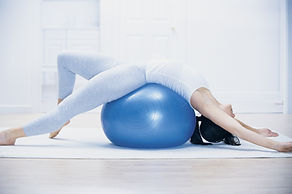
Pilates for Skiers
Bringing the Body Back to Balance
Pilates is excellent cross-training for skiers to regain muscle balance and avoid sport specific injuries. Bringing the body back into balance requires stretching the muscles that are dominant in skiing and strengthening the less dominant muscles. Many Pilates exercises do both simultaneously.
Muscles to Stretch: Quadriceps, Hamstrings, Iliotibal Band, Calves, Quadratus Lumborum, Hip Abductors, Hip Flexors, Pectorals, Upper Trapezius, Latissmus Dorsi.
Muscles to Strengthen: Medial Quadriceps, Tibialis Anterior, Abdominals, Hip Adductors, Hip Abductors, Hip Extensors, Rhomboids, Mid-Trapezius, Lower Trapezius.
Overuse Injuries From Skiing
Many skiers hang up their skis and poles and end their ski careers early as a result of an overuse injury. Overuse injuries are sport specific and often result from muscle imbalances caused by the demands of repetitive movement.
Over training, poor alignment and stance, and failure to cross train often leads to overuse injuries. For a skier, overly developed quadriceps muscles, underdeveloped hamstrings, and inner and outer thighs can place stress the soft tissues around the knees.
Likewise, a poor stance can create injury to a skier’s hips and back. Exacerbating the problem are structural misalignments such as leg-length discrepancy, legs that bow or knock-knees.
Common overuse injuries include: Anterior Cruciate Ligament (ACL) Injury, Chondromalacia, Medial Collateral Ligament (MCL) Injury, Meniscus Injuries, Patellofemoral Pain Syndrome (Runner’s Knee), Patella Tendonitis (Jumper’s Knee), Shin Splints, Iliotibal Band Syndrome and Sciatica.
Skiers and Knee Injuries
Skiers run the risk of many different injuries. In particular the knees, where I’ve seen a lot of tears of the anterior crutiate ligament (ACL), medial collateral ligament (MCL), and the meniscus.
Pilates helps skiers really focus on a dynamic and full range of motion and the strengthening of the hamstrings, which can help balance overused quads as well as serve as back up support for the ACL.
Exercises that emphasize the adductors can help a skier’s recovery from catching an edge or keeping the skis under the center of the body, thus reducing the stress on passive structures such as the MCL.
In addition, closed chain exercises (where the foot is in contact with bar/strap/board/floor) can help simulate proper muscle recruitment and timing as well as provide functional applicable movements for skiing.
Using specific exercises to focus on VMO (vastas medialis oblique of the quadriceps) and glute medius are important for proper patella (knee cap) tracking and stability of the knee and hip joints.
Skiers and Lower Back Injuries
Another area I see injured or overused a lot in skiing is the lower back. Injuries here often occur from form fatigue and poor core stabilization.
Often the hip or lower extremity moves and then the pelvis and lumbar spine follow, increasing the stress on the spine as well as causing unnecessary muscle imbalances, compensations, and ultimately injuries.
This increased motion of the trunk requires increased energy as efficiency of movement is lost, speed of fatigue is gained.
For further information, please do not hesitate in contact us.
info@connecthealthandfitness.com



